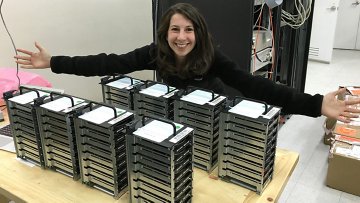Extract from ABC News
This is a week in which our collective imagining of the universe has changed.
Overnight on Wednesday, Australian time, a 200-strong team of scientists unveiled humanity's first proper portrait of a black hole.
They didn't just model it, predict it, visualise it and illustrate it; they reached across to a nearby galaxy and recorded it.
A monstrous, spherical frontier of our observable universe. An eater of space-time.
And now we've all seen it.
But only just. From endless theoretical calculations, to painstaking technical efforts, to the limits of the laws of physics: there were a lot of ways this effort could have come unstuck.
Here are five surprising aspects of the project that didn't necessarily make the headlines.
Overnight on Wednesday, Australian time, a 200-strong team of scientists unveiled humanity's first proper portrait of a black hole.
They didn't just model it, predict it, visualise it and illustrate it; they reached across to a nearby galaxy and recorded it.
A monstrous, spherical frontier of our observable universe. An eater of space-time.
And now we've all seen it.
But only just. From endless theoretical calculations, to painstaking technical efforts, to the limits of the laws of physics: there were a lot of ways this effort could have come unstuck.
Here are five surprising aspects of the project that didn't necessarily make the headlines.
1. One millimetre FTW
At the heart of this discovery is a fortunate cosmic coincidence.Spotting the silhouette of a supermassive black hole means we need light shining around it.
So the researchers running the Event Horizon Telescope (EHT) had to pick a wavelength of light that shines brightly from the superheated gas roiling around its perimeter.
But then, those photons had a journey ahead of them. Once spat out from the fringes of the black hole, they had to penetrate all the other matter falling towards this giant object, as well as the stuff orbiting around it — and this thing at the centre of a vast, elliptical galaxy.
Finally, after shining through the dust of M87, travelling for 55 million years and entering our own Milky Way, this light had to pass through the Earth's own soggy atmosphere.
There aren't many colours of light that meet these exacting specifications.
After literally millions of computer simulations, the EHT team settled on their best bet, wavelength-wise.
"Light rays of a millimetre wavelength, radio waves, can make that journey," said EHT director Shep Doeleman.
Specifically, EHT's global network of dishes was fine-tuned to simultaneously collect radio waves 1.3 millimetres long: a much larger wavelength than visible light, but much shorter than the radio waves we use to watch TV.
And surely a new favourite measurement for astrophysicists everywhere.
2. PhD student Katie Bouman and her mad coding skills
Scientist Katie Bouman just posted about the moment when "the first image I ever made of a black hole" was processed.
Just to clarify, this was the first image *ANYONE EVER MADE* of a black hole. #smalldetails http://bit.ly/2G3CUUo #EHTBlackHole #BlackHoleDay #BlackHole
She was a PhD student at MIT when she created what she called CHIRP, or Continuous High-resolution Image Reconstruction using Patch priors.
This code was a key step in synchronising the signals from eight scattered radio telescopes — which, because of the distances between them and the interference of our atmosphere, actually received the critical signals at slightly different times.
"Radio wavelengths come with a lot of advantages," Dr Bouman, who received her doctorate in 2017, told MIT News in 2016 when her new algorithm was announced.
"Just like how radio frequencies will go through walls, they pierce through galactic dust. We would never be able to see into the centre of our galaxy in visible wavelengths because there's too much stuff in between."
A photo of Dr Bouman with stacks upon stacks of hard drives full of Event Horizon Telescope data evoked the iconic image of fellow computer scientist Margaret Hamilton with the software (in paper form) she developed for the Apollo space program's on-board flight system in the 1960s.


Computer scientist Katie Bouman and her awesome stack of hard drives for #EHTblackhole image data— reminds me of Margaret Hamilton and her Apollo Guidance Computer source code.
3. When your carry-on baggage is petabytes of data
Those stacks of hard drives illustrate another jaw-dropping aspect of the EHT: it created too much data to be stored online.When the planet-straddling instrument turned its eight dishes towards M87 in April 2017, it started amassing recordings that measured in the petabytes — a petabyte being 1,000 terabytes, or 1 million gigabytes.
In fact, the files were too big for the internet; team members literally had to carry their findings around the world on high-performance, helium-filled hard drives.
"We had five petabytes of data recorded," said Daniel Marrone, from the University of Arizona.
No internet connection can rival the transfer speed, Dr Marrone said, of putting a petabyte of data onto a plane.
So from telescopes situated on volcanoes in Hawaii and Mexico, mountains in Arizona and the Spanish Sierra Nevada, the Chilean Atacama Desert and even Antarctica, precious troves of data were manually ferried to the Max Planck Institute for Radio Astronomy in Germany and the MIT Haystack Observatory in the United States.
There, highly specialised supercomputers called correlators combined and reduced the data, so that cloud computing could be used for the subsequent stages.
When it came to the final step of creating the picture we all saw on Wednesday, four separate teams were set up to analyse the data from M87 independently.
"We told them, don't talk to each other or anyone else; choose whichever imaging algorithms you think are best, and make images of these data," Dr Marrone explained.
When the four teams were reunited at a meeting in 2018, four distinct but very similar images were revealed.
"It was a wonderful day of science," Dr Marrone said.
4. That's not really a ring
It might look like you can see brightly shining matter swirling in a circle around the black hole itself — as if that ring were sitting face-on, perpendicular to our line of sight.But in fact, the already iconic circular shape is a product of much weirder physics.
Einstein never liked the idea of black holes, but they were a prediction of his theory of general relativity. And that theory says that a black hole, especially one this huge, wobbles and warps space-time like the fabric of a slack trampoline.
It's those bends, not a spinning ring of fire, that creates the shape we see.
"That perfect circle … comes from light that has been bent by the gravity of the black hole," said Professor Tamara Davis from the University of Queensland.
"The path of the light is curved and goes around and then comes towards us, forming a ring around that dark disc."
5. Supermassive means … supermassive
There's been a lot of talk about size. And with an event horizon 30,000 times bigger than the Sun, that's justified; this black hole is a whopper.But what's more important for its role in the universe is its mass — and this thing is really, really, really, really, really, really, REALLY heavy.
It's carrying 6.5 billion solar masses and all of that, according to Einstein's theory, is concentrated at an infinitely small point called the singularity.
No wonder the entire galaxy of M87 spins around it.
We've got a beast like this in the Milky Way as well; it's pokey by comparison, at about 17 times the size of the Sun and only (only!) 4 million times its mass.
But it's still supermassive, and it still has the whole galaxy, including our little solar system, turning around it every 230 million years.
That black hole is known as Sagittarius A*, and it's the next target for the EHT.
Now we know how well this instrument works, it's only a matter of time before we glimpse it.











No comments:
Post a Comment